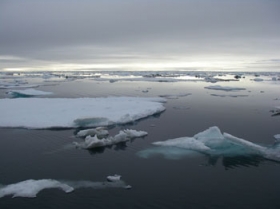Feedback Accelerates Arctic Ice Melt — Canada, Alaska Most Pronounced

Scientists at NASA and the National Snow and Ice Data Center
published research last week in the Journal of Geophysical Research
based on satellite microwave data of seasonal Arctic ice thaw from 1970
to 2009. The study indicates the seasonal Arctic sea ice melt melt
season is now about 20 days longer than it was 30 years ago.
The growing season of thaw is most pronounced in Arctic waters off the
coasts of Alaska and Canada, including the Chukchi and Beaufort seas,
where the season is 30 days longer now than in 1979. East Greenland and
the Hudson Bay also share nearly a month longer of seasonal melt. The
Hudson Bay exhibits one of the fastest increases in seasonal melt on the
globe.
On average, seasonal melt has increased about 2.5 days per decade and
lasts 3.7 days longer — an average of just under 20 days since 1979.
"With the exception of the Sea of Okhotsk, all areas in the Arctic show
a trend toward earlier melt onset and also a trend toward later freezeup,"
researchers said in their published report.
Scientists suggest that the longer melt season creates a feedback loop
further accelerating warming in the region. When the ice melts, darker
ocean water absorbs more heat from the sun. With a longer melt season
there is more time for these dark waters to absorb more heat, adding
further to ice loss. The delayed fall freeze also means thinner ice
reforms every season, leading to increased ice loss in the coming thaw
next season.
NASA has recently published research showing that average thickness of
Arctic sea ice shrank 2.2 feet between the winters of 2004 and 2008,
with the surface area covered by multi-year ice shrinking by more than
42 percent.
As goes the ice in the Arctic waters so goes conditions on land. The National Oceanic and Atmospheric Administration said the changes observed in sea ice leads changing conditions on land. Those changes include warmer fall temperatures, making was for a northward march of trees and shrubs into areas that were once frozen tundra. The changing patterns on land and sea rise up into the atmospheric circulation patterns in northern Alaska and Canada, all the way down to mid-latitude North America.
To subscribe or visit go to: http://www.globalwarmingisreal.com